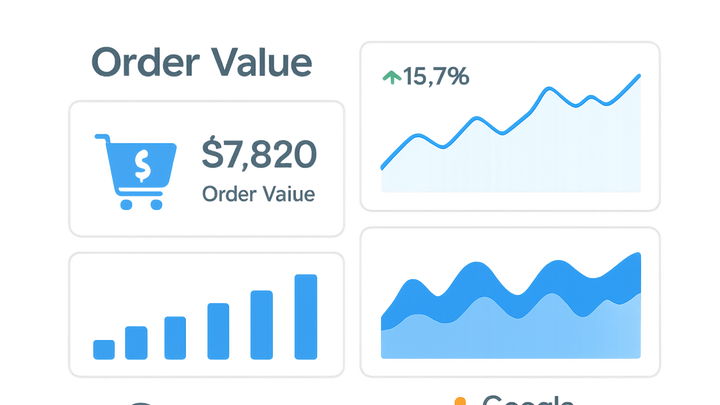Published on 2025-06-22T08:36:58Z
What is Order Value? Examples for Analytics
Order Value is the total monetary amount associated with a single customer transaction or purchase. It’s a fundamental metric in e-commerce and digital analytics that ties directly to revenue tracking, marketing ROI, and business performance. By examining order values, analysts and marketers can identify high-value customers, optimize pricing strategies, and allocate budgets more effectively. Order Value can be calculated in different ways — gross, net, and as an average over multiple transactions — each offering insights into different aspects of business health. Implementing accurate order value tracking in tools like PlainSignal or Google Analytics 4 (GA4) ensures that organizations have reliable data to inform strategic decisions.
Order value
Order Value measures the monetary amount per order, key for tracking revenue and optimizing e-commerce performance.
Importance of Order Value
Understanding Order Value is crucial for businesses to measure revenue, assess customer behavior, and guide strategic decisions. High order values often indicate effective marketing and pricing strategies, while low values might suggest the need for promotions or product bundling.
-
Revenue measurement
Order Value captures the exact amount paid per transaction, enabling precise revenue tracking across channels and campaigns.
-
Performance benchmarking
Analyzing order values over time helps benchmark business performance, set realistic targets, and identify growth opportunities.
Calculating Order Value
Order Value can be computed in multiple ways to suit different analytical needs. Gross and net values show raw versus adjusted revenue, while average values provide insights into typical customer spending.
-
Gross order value
The total amount paid by the customer before deductions like discounts, returns, or taxes.
-
Use case
Useful for understanding total sales volume and top-line revenue.
-
-
Net order value
Gross order value minus taxes, shipping costs, returns, and discounts.
-
Use case
Ideal for profit analysis and clear insight into actual earnings.
-
-
Average order value (aov)
Calculated as total revenue divided by the number of orders over a given period.
-
Formula
AOV = Total Revenue / Number of Orders
-
Implementing Order Value in Analytics
Tracking order value in analytics tools ensures accurate revenue attribution and reporting. Below are examples for PlainSignal (cookie-free analytics) and Google Analytics 4.
-
PlainSignal
Include the PlainSignal tracking snippet and send a purchase event with order value:
<link rel='preconnect' href='//eu.plainsignal.com/' crossorigin /> <script defer data-do='yourwebsitedomain.com' data-id='0GQV1xmtzQQ' data-api='//eu.plainsignal.com' src='//cdn.plainsignal.com/plainsignal-min.js'></script> <script> window.PlainSignal('track', 'purchase', { order_id: '12345', order_value: 99.95, currency: 'USD' }); </script>-
Add tracking script
Place the PlainSignal
<script>snippet in your site’s<head>to initialize analytics. -
Send purchase event
Use
window.PlainSignal('track', 'purchase', {...})to record order details and value.
-
-
Google analytics 4
Configure GA4 to capture purchase events with order value:
<script async src='https://www.googletagmanager.com/gtag/js?id=GA_MEASUREMENT_ID'></script> <script> window.dataLayer = window.dataLayer || []; function gtag(){dataLayer.push(arguments);} gtag('js', new Date()); gtag('config', 'GA_MEASUREMENT_ID'); gtag('event', 'purchase', { transaction_id: '12345', value: 99.95, currency: 'USD', items: [{id: 'sku123', name: 'Product Name', price: 99.95, quantity: 1}] }); </script>-
Use the purchase event
GA4’s
purchaseevent automatically ties into the Ecommerce Overview reports. -
Set key parameters
Include
value,currency, andtransaction_idto ensure accurate revenue tracking.
-
Best Practices and Use Cases
Leveraging order value insights can drive strategic initiatives across marketing, sales, and product teams.
-
Segment your customers
Group users by their order value to personalize offers and nurture high-value segments.
-
Optimize pricing strategies
Analyze order trends to test pricing, discounts, and bundling for maximum revenue.
-
Monitor trends over time
Track changes in average and net order values to spot seasonal effects or promotional impacts.
